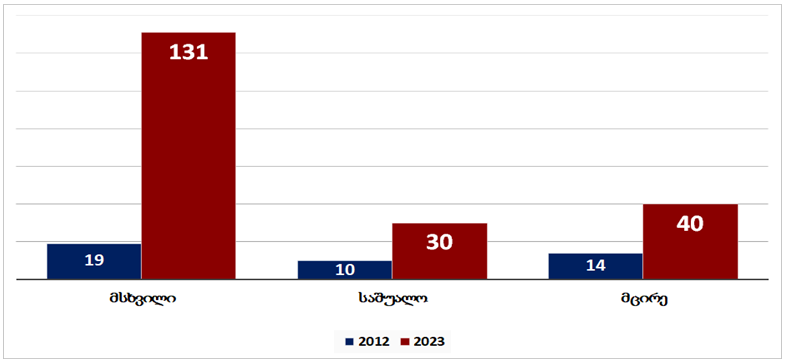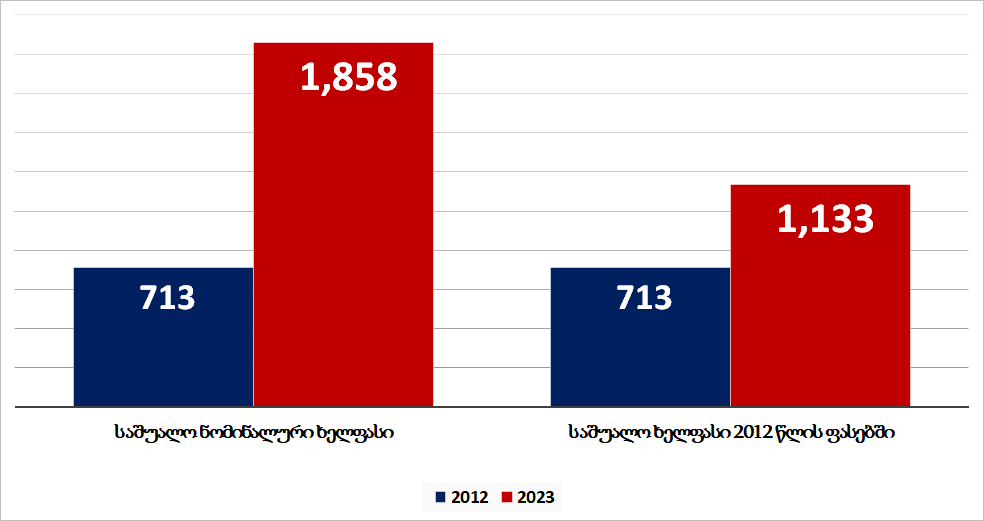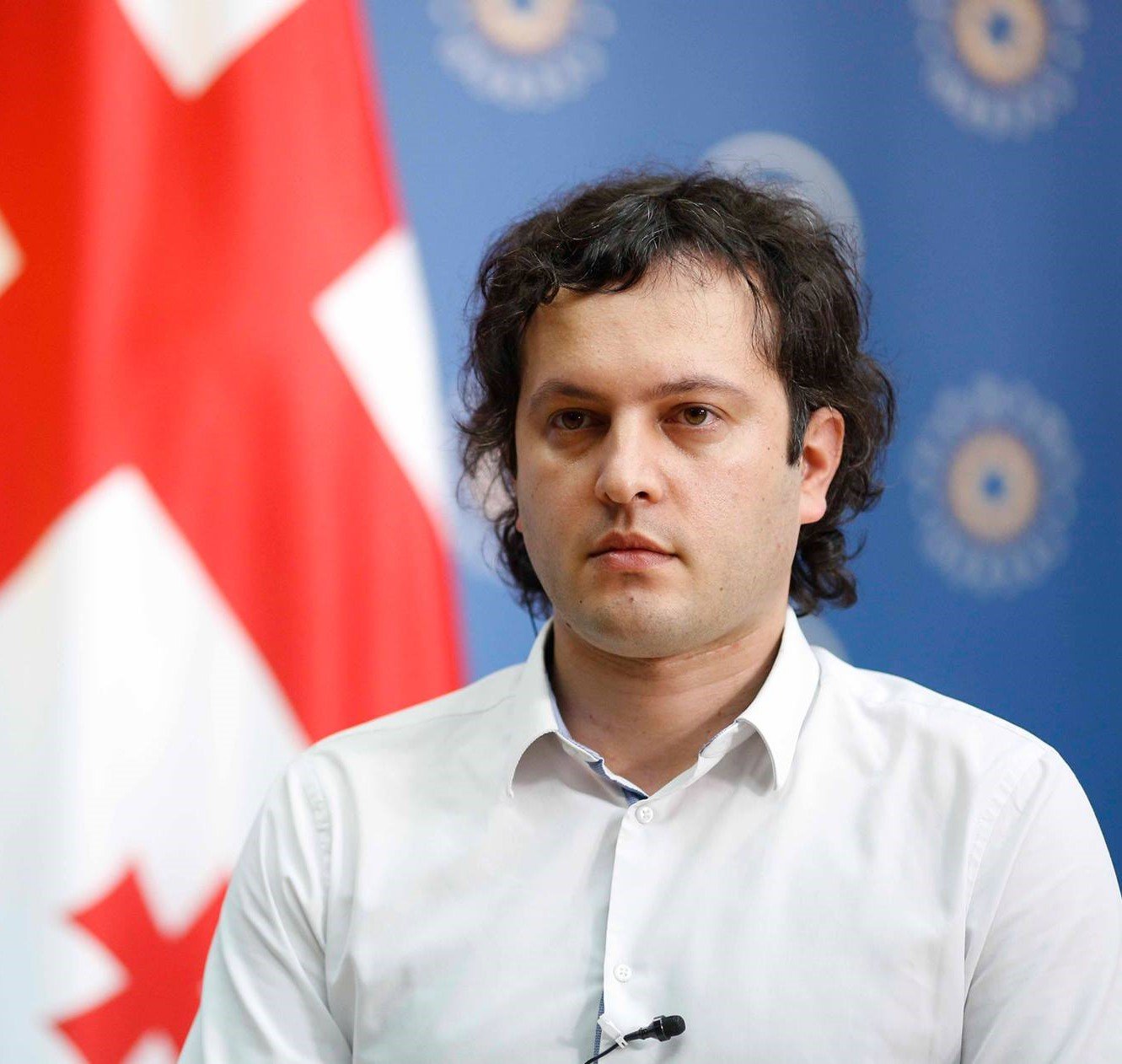Irakli Kobakhidze: “Business sector turnover has increased five-fold while salaries in the business sector have tripled.”
Verdict: FactCheck concludes that Irakli Kobakhidze’s statement is HALF TRUE.
Business sector turnover amounted to GEL 42 billion in 2012 whilst it was 4.8 times higher in 2023 at GEL 200 billion. This increase in turnover was influenced not only by the growth in the real economy but also two additional factors: the above-average rise in betting-related revenues, surging from GEL 1.1 billion to GEL 64 billion, and inflation, due to a 64% rise in the prices of consumption goods from 2012 to 2023.
Notably, nominal income increased 2.6 times from GEL 713 to GEL 1,858 during the aforementioned period. However, the increase in income was 1.6-fold, from GEL 713 to GEL 1,133 when adjusted for inflation in 2012 prices (whilst the 2023 salaries are not categorised by sector, the difference in wages between those employed in the business sector and the general average wage never exceeded 4% from 2012 to 2022).
Although the presented nominal figures for business turnover and average salaries are more or less accurate, the inflationary effect and the abnormal increase in gambling turnover are not factored in which can create a misleading impression of economic growth. Considering all of the above, FactCheck concludes that Irakli Kobakhidze’s statement is HALF TRUE.
Analysis
During his electoral campaign visit to Mtskheta, Prime Minister Irakli Kobakhidze highlighted several economic figures, stating: “Business sector turnover has increased five-fold while salaries in the business sector have tripled.” Business sector turnover amounted to GEL 42 billion in 2012 whilst it was 4.8 times higher in 2023 at GEL 200 billion. Growth rates varied across different sectors. For instance, infrastructure turnover increased 2.6 times, industry tripled, trade rose 3.6 times and education - 4.4-fold whilst that of the gambling sector surged 59 times. Particularly, the turnover in betting-related revenues experienced a growth of 5,800% during the aforementioned period whilst the turnover of the second-fastest growing sector, namely real estate activities, increased by 420%. Moreover, the share of gambling game turnover accounted for 2.6% of the total figure which rose to 32% by 2023. Notably, the overall business turnover growth would reduce to 3.3-fold, excluding gambling.
Graph 1: Business Turnover (GEL Billion)

Source: National Statistics Office of Georgia
Percentagewise, a 4.8-fold growth represents 380% and 3.3-fold growth is equal to 230%. Whilst the real economy expanded by 70% during the governance of the Georgian Dream, consumption goods prices also increased annually, thus contributing to a higher nominal economic growth.
The total rise in consumer prices from 2013 to 2023 amounted to 64% equating the purchasing power of GEL 42 billion in 2012 to GEL 69 billion in 2023. Business turnover also grew monetarily in 2009 and 2020 when the real economy decreased by 3.7% and 6.3%, respectively.
The business turnover growth reduces to 190% between 2012 and 2023 when adjusting for inflation and further decreases to 103%, excluding gambling games.
Inflation is one of the primary underlying factors that explains why the business turnover increased by an even higher amount of 660%, reflecting a rise from GEL 5.5 billion to GEL 42 billion, during a shorter period from 2003 to 2012 under the governance of the United National Movement.
Factories are categorised into three groups according to their sizes: the average annual employment of small enterprises does not exceed 50 whilst their annual turnover is less than GEL 12 million; the number of employees in medium enterprises is between 50 and 250, whereas their annual turnover falls between GEL 12 million and GEL 60 million; enterprises that employ more than 249 individuals and have their annual turnover exceed GEL 60 million are categorised as large. The turnover growth varied across different sizes of enterprises with large businesses experiencing a seven-fold increase, medium enterprises having a three-fold growth and small enterprises recording a 2.9-fold rise. As a result, the share of large enterprises in overall turnover increased from 44% to 65%; however, that of medium businesses decreased from 24% to 15% and that of small enterprises decreased from 32% to 20%.
Graph 2: Business Turnover by Enterprise Size (GEL Billion)

Source: National Statistics Office of Georgia
Tbilisi accounted for 74.5% of the total business turnover in 2012 with the share increasing to 78.7% by 2023. Furthermore, the share of state enterprises decreased from 4.7% to 2% during the same period.
Whilst limited liability companies and joint stock companies reflected 90% of the total business turnover in 2012, their share increased to 96% in 2023. Individual entrepreneurs rank third. The total share of joint liability companies, limited partnerships and cooperatives amount to 0.3% of the figure.
Graph 3: Business Turnover by Legal Forms of Organisation (GEL Billion)

Source: National Statistics Office of Georgia
The growth rate in production value was slightly less at 3.2 (220%) than that of turnover. Production value increased from GEL 23.6 billion to GEL 75.3 billion in the aforementioned period (the growth was 6.7-fold between 2003 and 2012 - from GEL 3.5 billion to GEL 23.6 billion). The information and communications sector experienced the highest growth of 350% in production value, increasing from GEL 400 million to GEL 1.1 billion.
The average nominal gross salary amounted to GEL 713 in 2012 (equivalent to GEL 570 after taxes) which increased 2.6-fold to GEL 1858 in 2023 (equivalent to GEL 1,457 after taxes). Notably, GeoStat has not categorised 2023 salary data by sector and gender. The remuneration in the industry sector increased from GEL 714 to GEL 1,605, representing a 125% growth in 2022 as compared to 2012, whilst the overall average salary had increased by 117%, from GEL 713 to GEL 1,543. The difference in wages between those employed in the business sector and the general average wage never exceeded 4% from 2012 to 2022, suggesting that this proportion was likely similar in 2023.
It is essential to consider inflation when discussing wages, as not the nominal salary that an employee earns, but the purchasing power of that amount is the key factor. A salary of GEL 1,858 in 2023 has the same purchasing power as GEL 1,133 in 2012. Therefore, the real increase in salary constitutes only 1.6 times over the reporting period which is significantly lower than the 200% increase highlighted by Irakli Kobakhidze.
Graph 4: Average Monthly Gross Salaries in GEL

Source: National Statistics Office of Georgia
The real economy has expanded by 70% since 2012 resulting in improvements in key economic metrics such as production, salaries, pensions and a reduction in poverty. However, claiming that business turnover has increased five-fold without further clarification might give the impression that the overall economy has growth by the same amount. In reality, two other factors influenced the nominal increase in turnover in addition to real turnover growth: the above-average growth rate in the gambling sector (where turnover surged by 5,800% as compared to a 380% increase in the total turnover) and inflation. Furthermore, inflation also accelerated nominal wage growth.
Although the presented nominal figures for business turnover and average salaries are more or less accurate, the inflationary effect and the abnormal increase in gambling turnover are not factored in which can create a misleading impression of economic growth. Considering all of the above, FactCheck concludes that Irakli Kobakhidze’s statement isHALF TRUE.








